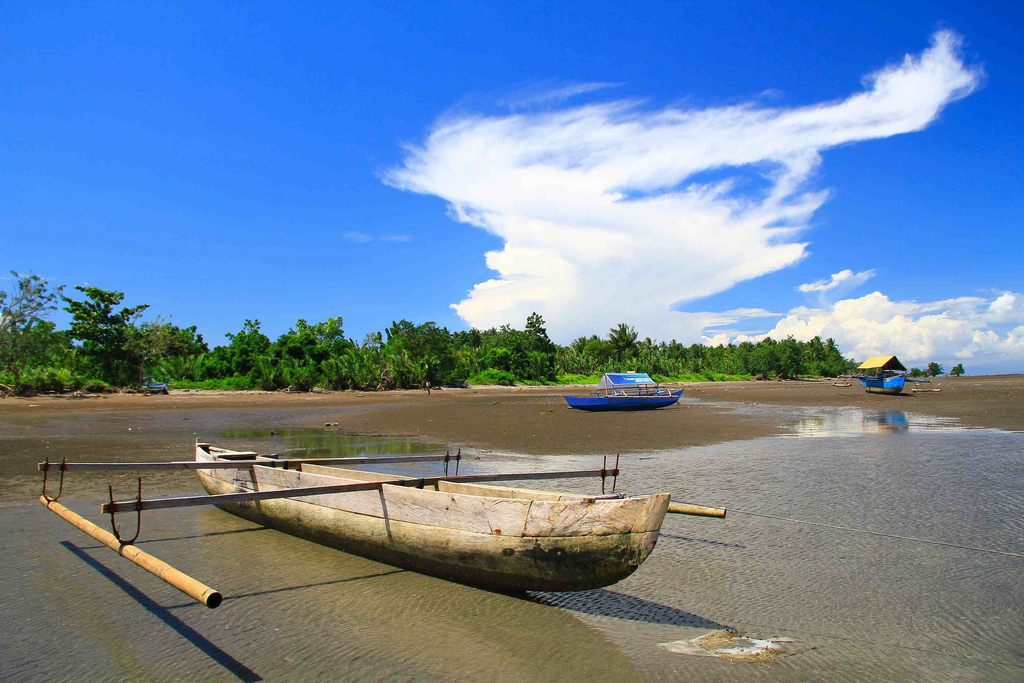Locals contest national citizenship rights in North Maluku
Safrudin Amin
In the 1970s, two normally sleepy places in North Maluku suddenly got busy. On Makian Island, off the west coast of the large island of Halmahera, thousands were evacuated. A volcano had threatened to erupt and cause disaster. The social welfare minister, Mintareja, moved them to the sub-district of Kao in North Halmahera. The new settlement was called Malifut. Locals in North Halmahera were moved out to surrounding areas – notably to Sosol – to make room for the forcibly evacuated Makian. Everyone did as they were told, with little apparent friction. But thirty years later, in 1999–2000, a big fight erupted between the Makian in Malifut, who were Muslim, and the Kao, who were mostly Christian.
Some of the Makian migrants told me they recalled there had been no resistance from the locals when they arrived in the 1970s. ‘When Vice President Adam Malik came to Malifut in 1975 to officially launch the Makian move here, the locals welcomed him and his entourage with a ritual cakalele dance. Now their descendants are asking what right we have to live here.’
In some ways the change of attitude is not hard to understand. The migrant residents have become quite dominant in the Malifut sub-district (which was created out of Kao some years ago). Where the locals once had plenty of land to occupy, now they feel pressed upon by expanding migrant settlements. When they first moved to Sosol the surrounding land was empty; now it lies on the outskirts of Malifut. Afrida Erna Ngato is one of the Kao locals. Aged about 40, she is recognised as a traditional chief, or sangaji, for the ethnic Pagu, a sub-group of the Kao. She is well educated and works as a civil servant in North Halmahera. She told me, ‘When the migrants came here in 1975, Sosol was still mainly farming land. Since the 1990s it has become built-up, so we have less land to live off.’ The village of Sosol where she lives is now surrounded by migrant villages. ‘To the north is Samsuma Village, to the south Tahane, to the west Matsa, and to the east is the sea,’ she said. With nowhere to expand to, one house often has to accommodate more than one family. Moreover, much of their farming land has been taken over by the new arrivals. ‘The Pagu have been marginalised by the state, by the migrants, as well as by the mining company NHM (PTT Nusa Halmahera Minerals) operating here. It is like genocide of the Pagu tribe,’ she said.
One of the arguments the largely Christian Kao made during their conflict with the Makian in Malifut in 1999–2000 was that all the Kao land, including Malifut, belonged to the Sultan of Ternate. The sultan had granted it to the Kao. The Makian therefore had no right to be there at all. Apparently Sultan Mudafar Syah of Ternate had indeed written a letter to that effect at the time tensions were running high. The Makian insisted that, if this really was the sultan’s land, they had every right to live there, because they too were subjects of the sultan. They should be able to live anywhere within the Ternate sultanate.
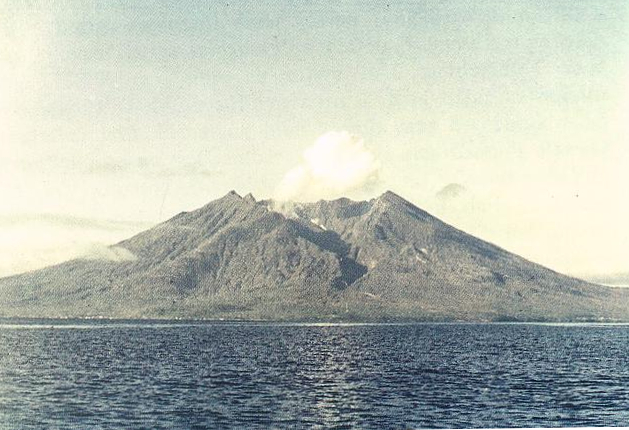 |
|
A digitised photograph of the active Makian volcano, Kie Besi. Its last major eruption in 1988 greatly damaged its surroundings. (Sumaryono/Volcanological Survey of Indonesia) |
While the fighting raged, the Makian and other migrants left their settlements in Malifut. When peace was eventually restored and they returned from their camps for the internally displaced, they faced rising demands to leave Malifut once again. One Makian person told me that one particular North Halmahera leader said, ‘Every suku (tribe) has their own territory. The Makian have theirs too. So let them go back to Makian Island.’ So now the argument from the elite Pagu was no longer that the land upon which they lived was the sultan’s, but that it was customary land belonging to the Pagu tribe. This was to counter the migrants’ response that they too had a right to live on the sultan’s land.
Pagu elites like Afrida believe that ownership of and access to traditional Pagu land should be in the hands of indigenous Pagu people. That power should not be concentrated, as now, in the hands of new arrivals. In 2010, Afrida’s Pagu group obtained the assistance of AMAN (the Alliance of Indigenous Peoples of the Archipelago). Afrida is Deputy Chair of AMAN for North Maluku, with special responsibilities towards women. The aim of the collaboration, she says, was to ‘revitalise’ Pagu culture and language. An information centre called Nanga Wola (‘our house’) was built next to Afrida’s home in 2015. To help the Pagu resist, AMAN made a map of Pagu customary land, based on oral interviews with Pagu elders. The map has been used to support Pagu demands towards the migrants (and towards NHM).
Several migrant people, Makian as well as non-Makian, told me that since returning from the refugee camps they often had to deal with Pagu people laying claim to their food gardens and even their houses. A non-Makian stone mason, a man aged 38 who came back to the area in 2000, said to me in 2013, ‘I was building my house in this Makian village in Malifut – it wasn’t finished yet – when Pagu people came and said this was their land and I had to pay for it. I had no choice but to pay up.’
Another migrant, a Makian, said the same thing. ‘They often came straight into my yard and staked out the land with string and a tape measure, even while we were inside our house.’ A migrant who originated from Galela on the north coast of Halmahera said he once had to yell at several people who were calmly measuring up the land around his house and climbing the coconut tree next to it.
In front of a local mosque I chatted with three people, one of whom told me, ‘Pagu people often roll out their tape measures as if they are measuring up an area of land there (pointing towards the road), but it is not clear what exactly they are measuring, and we take no notice of them.’ Somebody else added, ‘Yes, but in another village the Makian once chased them away.’
Makian migrants in another village had the same story. ‘They measure up the land near our house without us knowing what it is all about, without letting us know. Sometimes we manage to chase them away, sometimes we just let them be. There’s always the government.’
Some of the migrants feel almost terrorised. ‘Imagine, people claim that the land upon which we are living is theirs.’
Afrida acknowledges that such claims are happening. Asked if the claims were based on the land once owned by their ancestors, she said, ‘Oh yes, that is what they are thinking lately.’ In fact, she said, she often helped ‘resolve’ land disputes between her people and migrants at the sub-district office.
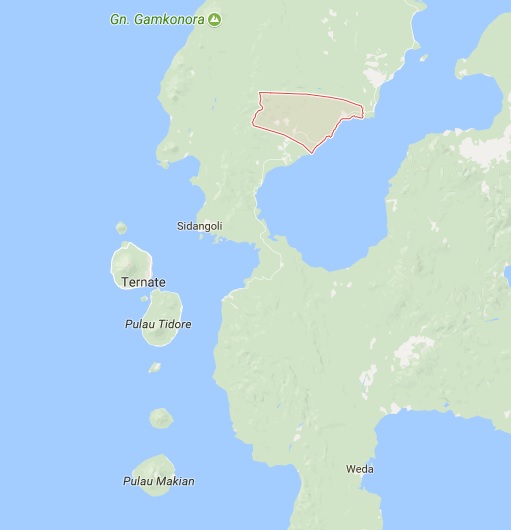 |
|
Makian Island (bottom left) and Malifut (area shaded in red). (Map data by Google) |
‘The problem,’ according to an official at the Malifut sub-district office, ‘is that most claims on land are just based on stories. There is no stronger proof of ownership. That makes it difficult to resolve. We often mediate between them and try to reach an agreement on how much compensation the migrant should pay. If there is no agreement, we invite them to go to the police and the law courts.’ He said a few did go to the courts, but most disputes were settled through negotiation, while a few were left unresolved.
Some migrants also regret the absence of written proof of land transactions that occurred between their parents and the Pagu owners years ago. ‘In the past everyone used a kind of fictive kinship called rasai. That was the way our parents exchanged things with the Pagu elders. The Makian gave some axes, a few dozen porcelain plates, or a roll of textile, and the Pagu people would respond by giving some land so their rasai brothers could grow their food,’ a Makian community leader told me. ‘As a result, a descendant of those people today will say this land belonged to their ancestors and that it should either be paid for or returned. Whereas on our side we don’t have written proof, because it was all based on this rasai agreement. It was just a story that was passed on to us.’
Becoming a Pagu?
Some Makian are now trying to persuade the Pagu to accept them as people who are also Pagu. One Makian leader said, ‘We have asked them repeatedly, in several meetings, “accept us as Pagu, we are prepared to become Pagu,” but they don’t want to. Pagu leaders like Afrida have always rejected us.’
Afrida acknowledged such requests have been made. ‘They often ask this at sub-district meetings,’ she said. But, she went on, ‘If they really want to become Pagu people, I feel a bit suspicious. Why? I am not insisting on it, feel free to live your life here as Makian people on Pagu land, but let us respect each other in the matter of living space. Don’t try to have it all your way.’
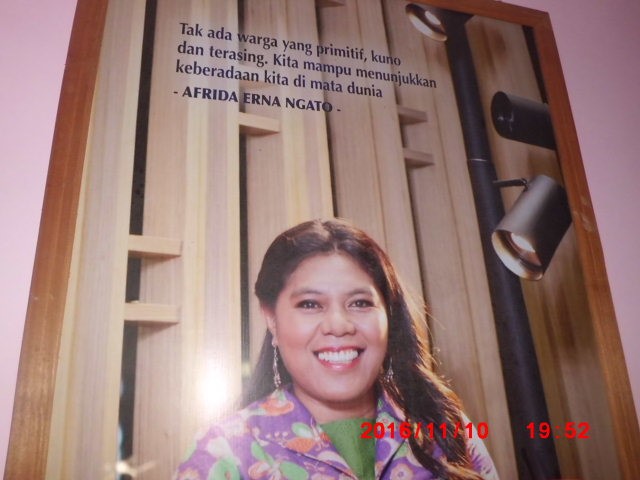 |
|
Afrida Erna Ngato's portrait, hung at home. "There is no such thing as ancient, primitive or alienated citizens. We can show the world that we exist." (Safrudin Amin) |
When AMAN helped the Pagu make the customary land map, they included the entire migrant settlement area in the map. They also included the entire concession controlled by the majority Australian-owned NHM. Why the map? I asked Afrida. Her answer reflected common AMAN discourse. ‘Because today we don’t live as we once did. This is no longer the era of just stories, of oral culture. Where once you could just say our land stretches from Rerecinga to Lame, now we have to have a document.’ The map was ‘the basis for a claim,’ she said. ‘With this map we can say we are indigenous people. Every development program that comes into our territory has to be discussed with the indigenous people. There can be no force. Not like the past, when suddenly there was NHM, suddenly there were these local transmigrants, or transmigrants from Java.’
The map was also the basis for claiming that all the resources that lie within it are owned by the Pagu, and not by the state or by the migrants. ‘I don’t feel superior, but I do feel that in this area “kami yang atur” (we set the rules). Because there is no fear greater than the fear of no longer having land… I give them this analogy, “We are natural-born children, you are adopted children. That’s right, isn’t it? But don’t worry, adopted children have rights too, arising from the adoption.” That’s my analogy.’ Clearly, I understood her to mean, natural children have more rights than those who are adopted.
The open-pit gold mine NHM is 75% owned by Australia’s Newcrest and 25% by Indonesia’s PT Aneka Tambang. But while Afrida also regards NHM as a threat to indigenous control over land resources, she still thinks the Makian are the greater menace. Asked who are the more dangerous, she says, ‘The Makian… because this can turn into a big conflict and they are very repressive and aggressive in wanting to control this area.’
When I asked the migrants about the map, many said it disturbed them. But others said they would entrust the problem to the government. ‘It was the government who brought us here by force,’ said one village leader. ‘So the government must protect our status here.’
Afrida regrets this hiding behind the state. ‘They always say this – “the government gave us this land” – but there is no such thing as state land. There is only customary land that has been seized by the state… The Makian migrants live on customary land, not on state land.’ She thinks it was a mistake for the government to have taken the parents of the Makian migrants from their home village and given them other people’s land. ‘This was a mistaken policy on the part of the state. The state has restricted our room for living (ruang hidup kami). That is why I don’t hesitate to say this is genocide,’ she said.
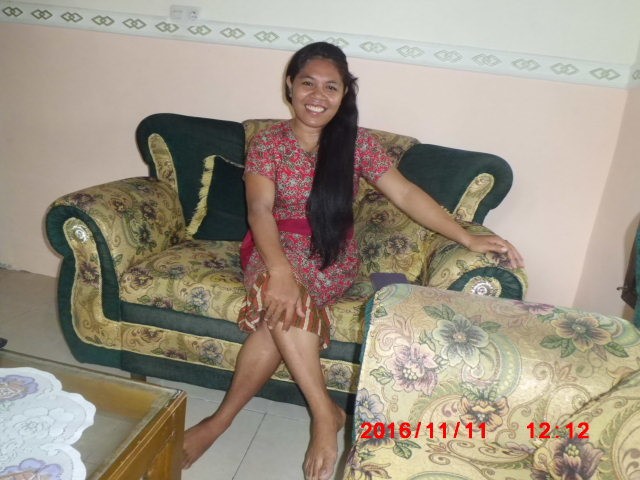 |
|
Afrida at home. (Safrudin Amin) |
The Pagu are not the only people who blame the state. Some Makian leaders do the same when they point out that the state never provided any written proof of the land it freed up for the Makian to live and farm on when they first evacuated them in the 1970s. A Makian village head said, ‘If at the time there had been a written agreement between the government and Pagu elders, today’s Pagu claims over residential and gardening land would not have happened.’
An older person who was part of the evacuation in the 1970s says the government must take responsibility. ‘That was the government’s mistake. We did not come here of our own accord. We were forced to move here under threat of guns (from the military). We were promised houses and a yard ready to move in, and land all set for planting. But they fooled us. We had to build our own houses, had to fell huge trees to clear the land for our gardens. Now that we have come this far, the government cannot just evade its responsibility.’
If Pagu activists like Afrida insist that the rights of ownership and access are conditional on customary membership, the migrants say that they have rights too. Rights to resources in Malifut arise because they are Indonesian citizens. Idrus Kahar, a Makian migrant who lived in Malifut and now resides in Ternate, said to the suggestion that the Makian in Malifut are illegal settlers because they live on customary land, ‘We have to use state law, because only state law respects the rights of all citizens.’
Another Makian informant told me, ‘When they try to revitalise customary law (membangkitkan adat) and use it to make land claims, that deeply disturbs us as citizens in Malifut… As far as I know all Indonesian citizens have a right to live anywhere within Indonesian territory.’ It is quite possible this person had heard of Clause 28E of the (amended) 1945 Constitution. This says that every citizen is free to chose where to live within Indonesian state territory, free to leave, and free to return again.
Another Makian leader said, ‘Adat must be parallel to, or not conflict with, state regulations. If adat conflicts, then state regulation must prevail, not adat.’ Such views turn up everywhere among migrant communities in Malifut, whether they originally came from Makian, Galela, Ternate or even from North Sulawesi and elsewhere.
The silent tension continues unabated as both sides – Pagu and migrants – blame the state. The state must act to resolve multiple problems: the shrinking living space for the Pagu, the citizenship status of migrants and a guarantee for the rights of everyone no matter which side they are on. If the state fails to act, some other group might turn up and exploit the situation by siding with one or the other in favour of their own agenda. That would ultimately disadvantage everyone.
Safrudin Amin (sasafamin3@gmail.com) is a lecturer in the Department of Social Anthropology at Khairun University, Ternate, North Maluku. This is one of a pair of articles on local versus national citizen rights. The other is When ‘home’ is not home by Laila Kholid Alfirdaus.

